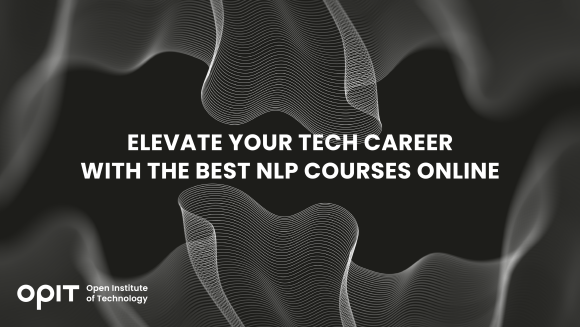Read the full article below (in Italian):


Natural language processing, or NLP for short, has been making waves for years, but as of late, it has caught the attention of even non-tech enthusiasts. Why is that? Simply put, natural language processing bridges human language and computer understanding to make interactions feel more natural and less like talking to machines.
For tech professionals, NLP skills have grown from “nice-to-have” status a few years ago to some of the most significant skills of the decade. The field is growing quickly, and many are interested in taking on the challenge. Luckily, many resources online can get you there and are flexible, in-depth, and practical.
Understanding Natural Language Processing
Natural language processing is an element of artificial intelligence (AI) that deals with the interaction between computers and humans using natural language.
Traditionally, human-computer interactions have largely been done through predefined commands within terminals or graphical user interfaces that obscure the “commands” behind graphical interactions. These interactions work well and aren’t going away. However, instructing a computer by “speaking” to it has been within the realm of science fiction for decades but has also been a research goal of many computer scientists for a long while.
The goal of natural language processing is to read, decipher, understand, and make sense of human language in a valuable way. Recently, it has been integrated into everything from search engines figuring out what users are searching for to translating languages on the fly. It’s even a part of predictive text that finishes sentences, particularly on mobile phone keyboards. Taking a course in NLP gives you a new skill for the CV that opens doors to many employment positions across sectors.
Choosing the Right NLP Course Online
When searching for the right NLP course, consider what you need. Specifically, focus on these:
- Curriculum
- Instructors
- Recognition
- Experience
Does the curriculum cover the latest in NLP technology? The field evolves fast, sometimes with several breakthroughs or at least advancements a year. Course material and curriculum that’s several years behind might miss some of the new developments.
Are the instructors seasoned professionals? The more experience one has in the field, the better equipped they are to pass that knowledge down.
Is the NLP course recognized by industry leaders? It isn’t a matter of appealing to authority but rather knowing that the course is of high enough quality to be considered valuable and useful.
And let’s not forget about the hands-on experience. You can’t really learn NLP just by reading about it. It would be best to try your hands in real-life projects and workshops.
Most NLP courses will walk you through the basics of machine learning, algorithms that power NLP, and hands-on projects that solidify your knowledge.
OPIT offers a full NLP course as a part of the Master of Science (MSc) in Responsible Artificial Intelligence program. The course gives you a solid theoretical foundation and plenty of hands-on experience, presented by instructors who are experts in the field. The degree teaches you how to use NLP and use it ethically and responsibly.
A List of the Best NLP Online Courses
Here are some standout NLP online courses:
- Coursera’s Natural Language Processing Specialization is for intermediate learners and spans over four months. It covers logistic regression, naive Bayes, word vectors, sentiment analysis, and more. The program is a comprehensive one that combines theory with practical assignments.
- Stanford Online’s Natural Language Processing with Deep Learning focuses on the cutting-edge intersection of NLP and deep learning. It’s an in-depth exploration of NLP’s fundamental concepts and its role in emerging technologies. This course is perfect for those looking to get a solid foundation in NLP from one of the leading institutions in the world.
- edX Natural Language Processing Courses & Programs: edX provides an intro to NLP that covers core techniques and computational linguistics. Topics include text processing, text mining, sentiment analysis, and topic modeling. It’s a great starting point for beginners and offers a broad overview of what NLP entails.
- DeepLearning.AI’s Natural Language Processing in TensorFlow on Coursera was designed by one of the pioneers in AI education. It offers practical insights into implementing NLP techniques using TensorFlow. The course covers processing text, representing sentences as vectors, and building NLP models.
- Udacity’s Natural Language Processing Nanodegree is project-focused with hands-on NLP learning. It covers foundational NLP concepts, including text processing, part-of-speech tagging, and sentiment analysis.
While these are the best natural language processing courses online, OPIT’s MSc in Responsible Artificial Intelligence, including NLP as part of its curriculum, is unique. This program teaches you NLP and embeds it within the broader context of artificial intelligence development, AI ethics, and responsible use. It’s excellent for those who want to go beyond the technical aspects and consider the societal impacts of their work in AI.
Benefits of Enrolling in an NLP Online Course
Attending an NLP course online might give you more than traditional on-site education. One of the biggest advantages is flexibility. You can learn at your own pace and on your schedule.
Online courses also open up networking opportunities with peers and mentors from around the globe. These are connections that on-site education would not have the scope to provide. Moreover, completing an NLP course can significantly boost your career prospects, potentially leading to job promotions and salary increases.
NLP Certification and Career Opportunities
With this certification, you’re proving your ability to understand and manipulate natural language data, making you invaluable in roles from data science and AI development to UX/UI design and content strategy.
Companies, from tech giants to startups, are on the lookout for professionals who can bridge the gap between human communication and machine understanding. The demand also translates into diverse job opportunities, competitive salaries, and the potential to work on groundbreaking projects in AI, machine learning, marketing, research, finance, and customer experience, among others.
Natural Machine Communication
NLP leads many of today’s technological advancements, making skills in this area more valuable than ever. Natural language processing courses that equip students with skills in natural language processing, AI, and related fields are growing in both offer and popularity. Completing one of these NLP courses sets you on a course for a financially promising career path within one of the most prestigious tech fields.
Get the right education and get ready for the future. Check out OPIT’s NLP course offerings within the MSc in Responsible Artificial Intelligence program or as a subject within our other computer science degrees.
Related posts

Source:
- Agenda Digitale, published on June 16th, 2025
By Lokesh Vij, Professor of Cloud Computing Infrastructure, Cloud Development, Cloud Computing Automation and Ops and Cloud Data Stacks at OPIT – Open Institute of Technology
NIST identifies five key characteristics of cloud computing: on-demand self-service, network access, resource pooling, elasticity, and metered service. These pillars explain the success of the global cloud market of 912 billion in 2025
Read the full article below (in Italian):

You’ve probably seen two of the most recent popular social media trends. The first is creating and posting your personalized action figure version of yourself, complete with personalized accessories, from a yoga mat to your favorite musical instrument. There is also the Studio Ghibli trend, which creates an image of you in the style of a character from one of the animation studio’s popular films.
Both of these are possible thanks to OpenAI’s GPT-4o-powered image generator. But what are you risking when you upload a picture to generate this kind of content? More than you might imagine, according to Tom Vazdar, chair of cybersecurity at the Open Institute of Technology (OPIT), in a recent interview with Wired. Let’s take a closer look at the risks and how this issue ties into the issue of responsible artificial intelligence.
Uploading Your Image
To get a personalized image of yourself back from ChatGPT, you need to upload an actual photo, or potentially multiple images, and tell ChatGPT what you want. But in addition to using your image to generate content for you, OpenAI could also be using your willingly submitted image to help train its AI model. Vazdar, who is also CEO and AI & Cybersecurity Strategist at Riskoria and a board member for the Croatian AI Association, says that this kind of content is “a gold mine for training generative models,” but you have limited power over how that image is integrated into their training strategy.
Plus, you are uploading much more than just an image of yourself. Vazdar reminds us that we are handing over “an entire bundle of metadata.” This includes the EXIF data attached to the image, such as exactly when and where the photo was taken. And your photo may have more content in it than you imagine, with the background – including people, landmarks, and objects – also able to be tied to that time and place.
In addition to this, OpenAI also collects data about the device that you are using to engage with the platform, and, according to Vazdar, “There’s also behavioral data, such as what you typed, what kind of image you asked for, how you interacted with the interface and the frequency of those actions.”
After all that, OpenAI knows a lot about you, and soon, so could their AI model, because it is studying you.
How OpenAI Uses Your Data
OpenAI claims that they did not orchestrate these social media trends simply to get training data for their AI, and that’s almost certainly true. But they also aren’t denying that access to that freely uploaded data is a bonus. As Vazdar points out, “This trend, whether by design or a convenient opportunity, is providing the company with massive volumes of fresh, high-quality facial data from diverse age groups, ethnicities, and geographies.”
OpenAI isn’t the only company using your data to train its AI. Meta recently updated its privacy policy to allow the company to use your personal information on Meta-related services, such as Facebook, Instagram, and WhatsApp, to train its AI. While it is possible to opt-out, Meta isn’t advertising that fact or making it easy, which means that most users are sharing their data by default.
You can also control what happens with your data when using ChatGPT. Again, while not well publicized, you can use ChatGPT’s self-service tools to access, export, and delete your personal information, and opt out of having your content used to improve OpenAI’s model. Nevertheless, even if you choose these options, it is still worth it to strip data like location and time from images before uploading them and to consider the privacy of any images, including people and objects in the background, before sharing.
Are Data Protection Laws Keeping Up?
OpenAI and Meta need to provide these kinds of opt-outs due to data protection laws, such as GDPR in the EU and the UK. GDPR gives you the right to access or delete your data, and the use of biometric data requires your explicit consent. However, your photo only becomes biometric data when it is processed using a specific technical measure that allows for the unique identification of an individual.
But just because ChatGPT is not using this technology, doesn’t mean that ChatGPT can’t learn a lot about you from your images.
AI and Ethics Concerns
But you might wonder, “Isn’t it a good thing that AI is being trained using a diverse range of photos?” After all, there have been widespread reports in the past of AI struggling to recognize black faces because they have been trained mostly on white faces. Similarly, there have been reports of bias within AI due to the information it receives. Doesn’t sharing from a wide range of users help combat that? Yes, but there is so much more that could be done with that data without your knowledge or consent.
One of the biggest risks is that the data can be manipulated for marketing purposes, not just to get you to buy products, but also potentially to manipulate behavior. Take, for instance, the Cambridge Analytica scandal, which saw AI used to manipulate voters and the proliferation of deepfakes sharing false news.
Vazdar believes that AI should be used to promote human freedom and autonomy, not threaten it. It should be something that benefits humanity in the broadest possible sense, and not just those with the power to develop and profit from AI.
Responsible Artificial Intelligence
OPIT’s Master’s in Responsible AI combines technical expertise with a focus on the ethical implications of AI, diving into questions such as this one. Focusing on real-world applications, the course considers sustainable AI, environmental impact, ethical considerations, and social responsibility.
Completed over three or four 13-week terms, it starts with a foundation in technical artificial intelligence and then moves on to advanced AI applications. Students finish with a Capstone project, which sees them apply what they have learned to real-world problems.
Have questions?
Visit our FAQ page or get in touch with us!
Write us at +39 335 576 0263
Get in touch at hello@opit.com
Talk to one of our Study Advisors
We are international
We can speak in:


